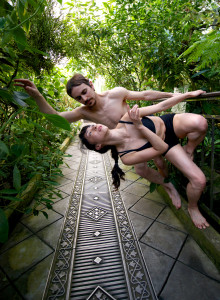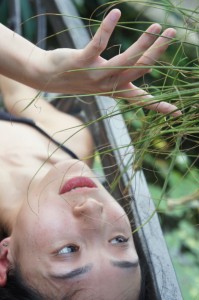Artistic collaboration is huge in today’s modern dance scene. And when something is so prevalent, there is a desire to categorize it; assign it a name and file it in under a heading—interdisciplinary; multi-genre; mixed media; new media. But none of these terms seem quite right. None fully embody the notion of artistic collaboration. Maybe it isn’t possible to reduce something so fluid, so evolutionary to a single word or phrase. Each collaborative journey is a complex and multifaceted undertaking where the imaginative spirit comes together in creative communion.

Photo by Andy Mogg
Contemporary choreographers have a rich history of thinking outside-the-box, looking beyond the expected and challenging norms. To that end, dance has merged (and continues to partner) with so many different and sometimes unexpected disciplines: text, music, video, architecture, visual art, costume design, puppetry. In order to reach the desired outcome, some pieces have a two-person team, while others utilize multiple creative forces. Above all, collaboration in modern choreography is an interdependent process—adding, changing, morphing, learning—and it speaks to the choreographer’s aesthetic goals, artistic vision and personal history.
A queen of collaborative dance performance, Kim Epifano, has spent her entire career fascinated with how places, people and structures can inform dance, movement and choreography. More than thirty years ago, she came to the San Francisco Bay Area to continue this personal and creative investigation. In these past three decades, Epifano’s choreographic endeavors have become intertwined and enmeshed with the historic landmarks and natural wonders of this region; its population and landscapes becoming her invaluable artistic collaborators. In 1997, Epifano founded Epiphany Productions Sonic Dance Theater, a company whose interdisciplinary dance works (like the highly successful San Francisco Trolley Dances, presently in its 10th year) seek to engage the community and increase public access to dance and performance. Epifano continues to scour the pavement of San Francisco for new and unusual performance opportunities and she is concerned with “how places create themselves; who is drawn to a particular area; what is the personality of the architecture; what is the connectivity between one place and another; how can we raise awareness of specific places; how does your relationship to a space change after you’ve worked there?”
Epifano’s current venture is a true reflection of her artistic philosophy and choreographic vision. A site-specific, mobile work, Botany’s Breath premieres this July at the Conservatory of Flowers in San Francisco’s Golden Gate Park, with two shows each night. Audiences will travel through the Conservatory, stopping in each room to experience dance, music and light amongst the lush flora. The Conservatory of Flowers has always been very special to Epifano, a spot that she describes as “a precious international space with rich, peaceful imagery.” So when the chance came to create a new dance theater work there, she was all in.
The conception, development and production of Botany’s Breath are all about partnerships. And perhaps the most significant collaboration has been between Epifano and the Conservatory of Flowers itself. Some of the very first collaborators were Conservatory staff members—dedicated individuals with an ardent passion for the space. People like Morgan Davis and Jane Scurich shared Epifano’s passion for engaging the community and were so excited about the prospect of bringing new audiences to the Conservatory of Flowers. Their openness and enthusiasm was instrumental in making this project possible and setting its initial plans in motion. In addition, Epifano spent time with Lau Hodges, Director of Operations and Exhibitions, and the gardeners who tend the plant life in the different rooms at the Conservatory. She studied the horticulture, learned about its form and watched it shift over time.
Epifano talks about how these collaborative experiences helped shape Botany’s Breath: “by going in and working with the people who make the space go, the history of the dance was being built.” In site-specific work, the space itself also becomes a main collaborator, contributing the sensibilities of its landscape and the stories of its architecture. And this particular building certainly has a dramatic history.
Almost eighteen years ago, the Conservatory of Flowers was critically damaged in a series of winter storms. This year marks the tenth anniversary of its re-opening. Epifano notes that “this building has lived and thrived; its plants continue to live and thrive; it was meant to be a part of this city’s personality.” Honoring the Conservatory’s resolve and determination meant respecting the structure’s essence, and the opportunities and challenges that came with it, “the atmosphere and temperature of each room was so different and was going to inform the dance performance that would happen there and drive the artistic pathway.”
For example, Epifano and her team found that the Aquatics room had “a beautiful spiritual sense, but was also very damp-we had to think about what musical instrument would stay in tune in this unique environment.” Other rooms had pre-existing accompaniment, “we had to be mindful of sounds that were already in the space, like the Lowland Tropics room which has misters and fans-are we going to cover them, reveal them or incorporate them into the work?” “These logistics were real and we had to think through them, but being with and watching the plants evolve in the space also moved me to consider big questions when working in the studio,” adds Epifano. Questions like, “how do you embrace change, but respect where you come from; what does it mean to transform; how does the spirit evolve; how does the temperature in each room affect the dancers and the audience; how do we keep the state of the rooms while working in the studio?”

Photo by Kim Epifano
Joining Epifano on this collaborative adventure is an all-star group of Bay Area artists; a collective whose individual contributions enhance and enrich the piece as a whole. For music and sound, Epifano turned to two people that she has previously worked with: Norman Rutherford (performing musician) and Peter Whitehead (composer/musician). Epifano credits Rutherford and Whitehead with an “originality, sensitivity and desire to investigate” that really connected with the fundamental principles of the project. Both men create and construct musical instruments—a priceless gift for Epifano. Elaine Hamblin will serve as costume designer, having collaborated with Epifano on Einstein’s Daughter’s at the Cowell Theater. Ellen Bromberg took on the videography for Botany’s Breath, assisted by Ben Estabrook. As Epifano explains, the video is a special bridge between art and the community, “performances that are free and open to everyone are very important to me, and with Botany’s Breath being one of Epiphany Productions’ few paid performances, I knew that there still had to be a link between this piece and the public. Video was a fantastic way to accomplish this—Ellen and Ben’s living images will be projected on the outside of the building for all to see.”
Rounding out the extraordinary artistic team is lighting designer Allen Wilner. Together he and Epifano carefully weighed salient issues, including what needed to be lit and how to remain organic with the space. The resulting design is what Epifano calls “a simple and graceful presence.”
Last but certainly not least, Epifano has assembled an incredibly talented cast: Jesse Chin, Marina Fukushima, Nuria Bowart, Zoe Klein, Alex Zendzian, Alicia Ruth, Chris Black and Colin Epstein. The dancers, of course, are crucial collaborators in any choreographic project, as they are responsible for communicating the piece to the audience. But their collaboration begins far before the actual performances. In the studio, Epifano develops material through experimental improvisation using information generated while at the on-site rehearsals. She feels so fortunate to be working with these eight dancers, who are collaboratively meeting her in that process.
For Epifano, “this project brings together so many things that are important to me as I continue to grow as an artist and as a human being—community, articulation, change, organic-ness, nature….” Botany’s Breath is a prime example of artistic collaboration, a work combining dance, video, music, sound, light, costuming and a living set. The mystery of this process lies in how these elements are woven together, how the aggregate pursues a common goal and how each contribution propels the piece into new dimensions. And, as evidenced by Botany’s Breath, artistic collaboration is really about people-how they support, motivate, inspire and feed each other.
Botany’s Breath performances will take place July 10-13. To learn more about show times and tickets visit epiphanydance.org or conservatoryofflowers.org
This article appeared in the July/August 2013 issue of In Dance.

